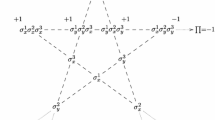Abstract
Heywood and Redhead's 1983 algebraic (Kochen-Specker type) impossibility proof, which establishes the inconsistency of a broad class of contextualized local realistic theories, assumes two locality conditions and two auxiliary assumptions. One of those auxiliary conditions, FUNC*, has been called a physically unmotivated,ad hoc formal constraint.
In this paper, we derive Heywood and Redhead's auxiliary conditions from physical assumptions. This allows us to analyze which classes of hidden-variables theories escape the Heywood-Redhead contradiction. By doing so, we hope to clarify the physical and philosophical ramifications of the Heywood-Redhead proof. Most current hidden-variables theories, it turns out, violate Heywood and Redhead's auxiliary conditions.
Similar content being viewed by others
References
M. Redhead,Incompleteness, Nonlocality, and Realism (Oxford University Press, Oxford, 1987).
P. Heywood and M. Redhead,Found. Phys. 13, 481 (1983).
S. Kochen and E. Specker,J. Math. Mech. 17, 59 (1967).
A. Fine,Found. Phys. Lett. 1, 91 (1988).
R. Clifton, J. Butterfield, and M. Redhead,British J. Phil. Sci., forthcoming (1990).
A. Fine,Found. Phys. 19, 453 (1989).
D. Bohm and B. Hiley,Found. Phys. 14, 255 (1984).
A. Fine,Synthese 29, 257 (1974).
Author information
Authors and Affiliations
Additional information
1. See Redhead [1], pp. 133–136, for a complete discussion.
2. Arthur Fine first pointed out the implicit reliance on FUNC*, and proved FUNC* to be both consistent with and independent of the Value Rule.
3. LetA=∑iai P i andB=∑jbj P′j be spectral resolutions ofA andB. Then <A,B> is the observable associated with maximal operatorR=∑ijfij P i⊗P′j, where fij=F(ai,bj), and where function F is 1:1.
4. Heywood and Redhead's versions of these conditions employ equivalence-class notation to specify the ontological context. {<D,E>}={R} refers to the equivalence class of all possible <D,E> formed by using different F functions (cf. Footnote 3). Clearly, such notation assumes that ifR andR′ are two distinct commuting maximal operators formed as described in Fn. 3 fromD andE using two different F(di,ej) functions, then [Q]t (R)(R)=[Q]t (R′)(R), so that [Q]t {R}(R) is uniquely defined.
Heywood and Redhead never rely upon this assumption in their proof, however. It is easily checked that a Heywood-Redhead contradiction follows from my non-equivalence class versions of OLOC, ELOC, VR, and FUNC*. Therefore, I will not use equivalence class notation.
5. Here I denote by µR the composite state of all the apparatuses needed to measure R. So µR may represent the state of more than one device.
6 This is because in a hidden-variables framework, quantum mechanical probabilities are a weighted average of the underlying hidden-variables probabilities.
7. This argument resembles a proof given by Fine [8].
8. Recall from theorem 1 that ifQ=f(R), then for all quantum states φ, Pφ(t)(Q≠f(r), R=r)=0.
Rights and permissions
About this article
Cite this article
Elby, A. On the physical interpretation of Heywood and Redhead's algebraic impossibility theorem. Found Phys Lett 3, 239–247 (1990). https://doi.org/10.1007/BF00666014
Received:
Revised:
Issue Date:
DOI: https://doi.org/10.1007/BF00666014




